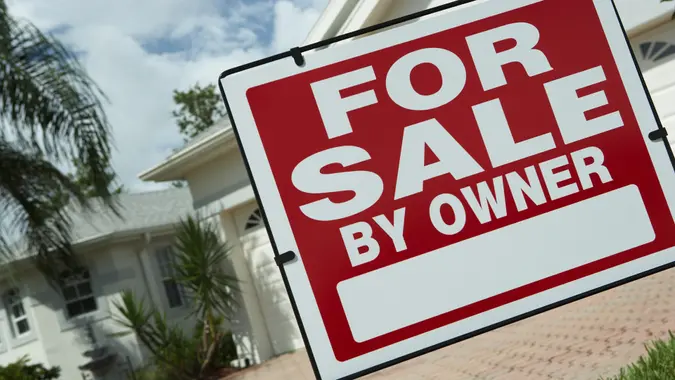Barbara Corcoran Swears By This ‘Golden Rule’ of Real Estate Investing

Commitment to Our Readers
GOBankingRates' editorial team is committed to bringing you unbiased reviews and information. We use data-driven methodologies to evaluate financial products and services - our reviews and ratings are not influenced by advertisers. You can read more about our editorial guidelines and our products and services review methodology.

20 Years
Helping You Live Richer

Reviewed
by Experts

Trusted by
Millions of Readers
Real estate investor and businesswoman Barbara Corcoran doesn’t believe in following the typical investing advice of portfolio diversification. In fact, she puts all of her money in her real estate brokerage firm, The Corcoran Group, and has earned millions of dollars as a result.
In an episode of “BiggerPockets” podcast, Corcoran sat down with Tom Higgins (her son), David Greene and Rob Abasolo about their experience investing in real estate and what Corcoran defines as the “Golden Rule” of investing.
Here’s the gist of it.
Also see whether Corcoran thinks houses will become more affordable soon.
What Is the ‘Golden Rule’ of Real Estate Investing?
Corcoran’s Golden Rule of real estate investing consists of two main parts. The first is being able to purchase property with at least 20% down, ideally in a location that has started seeing an increase in demand. The second is to have tenants living on that property paying the mortgage.
“If you can buy a property with 20% down, you break even, you get the tenants to pay your mortgage, you always make money,” Corcoran said. “And if you can saddle onto the back of an up-and-coming area, you’ll make a lot of money.”
By following these criteria, it’s possible to turn real estate into a highly lucrative investment.
But like the real estate market, the Golden Rule also has changed. Initially, Corcoran put down just 10% of the property value when buying homes. As housing prices and interest rates have continued to rise, however, she decided to up the percentage to compensate.
It’s OK To Break Even at First in Real Estate Investing
In the podcast, Greene asked Corcoran whether the goal was to break even or to have an income-producing property. As Corcoran noted with the Golden Rule, it’s important to start by breaking even. This, she said, generally works only when putting down at least 20% on a property.
There are many examples of Corcoran following her own rule and breaking even before turning a profit. In particular, Corcoran said breaking even in the first year or so of real estate investing is normal. But as property values rise and the mortgage balance decreases over time, it’s possible to see some significant returns.
As an example, she indicated that she made the 20% down payment on a property. Then, she waited for 20 years before selling it for a true profit.
By repeating the process of putting 20% down, holding onto a property, having paying tenants and eventually selling, Corcoran has made a killing in real estate. Currently, she has an estimated net worth of about $100 million.
There’s a Difference Between Residential and Commercial Tenants
For Corcoran, not all tenants are created equal. In fact, there are some key differences between residential and commercial tenants.
For one thing, residential tenants tend to view the place they’re renting out as a more personal housing option. Commercial tenants, meanwhile, tend to leave when they feel it’s no longer a good investment for them or their business.
Along with this, it’s often easier to increase the rent on residential properties than it is on commercial properties. This is the case both when a current tenant leaves and when a lease is up for renewal. This rent increase can lead to more gains over time. With commercial tenants, meanwhile, leases tend to be longer, so it takes more time to be able to increase the rent.
What Prompted Corcoran’s ‘Golden Rule’?
Corcoran wasn’t always a real estate mogul. When she first started out in 1973, she had just $1,000 to her name and seven real estate agents working under her firm.
One of her most significant early purchases was an office space in Fort Greene, a borough in Brooklyn, New York. The neighborhood wasn’t a well-known location for investors at the time, and it wasn’t until later that other brokers followed her lead and started buying up property in the area.
After that early Fort Greene purchase, Corcoran moved on to other neighborhoods. One particular purchase was on Lafayette Street. There, she bought a townhouse that contained a commercial space, along with six apartment units above that space.
As she continued to expand, she prioritized up-and-coming neighborhoods, paying tenants and having a large enough down payment to break even. All of this led to her Golden Rule of real estate investing.
Should Other Real Estate Investors Follow the Golden Rule?
For Corcoran, real estate investing is all about breaking even by putting at least 20% down and getting regular, long-term paying tenants to cover any mortgage or maintenance costs. Only once a property has increased in value enough is it time to sell or refinance it for a profit.
For real estate investors who are just starting out, Corcoran suggested doing much the same. Start by purchasing property with a large down payment and then wait before taking out any money. Once the property has matured, it can be sold for a profit.
 Written by
Written by  Edited by
Edited by 

























